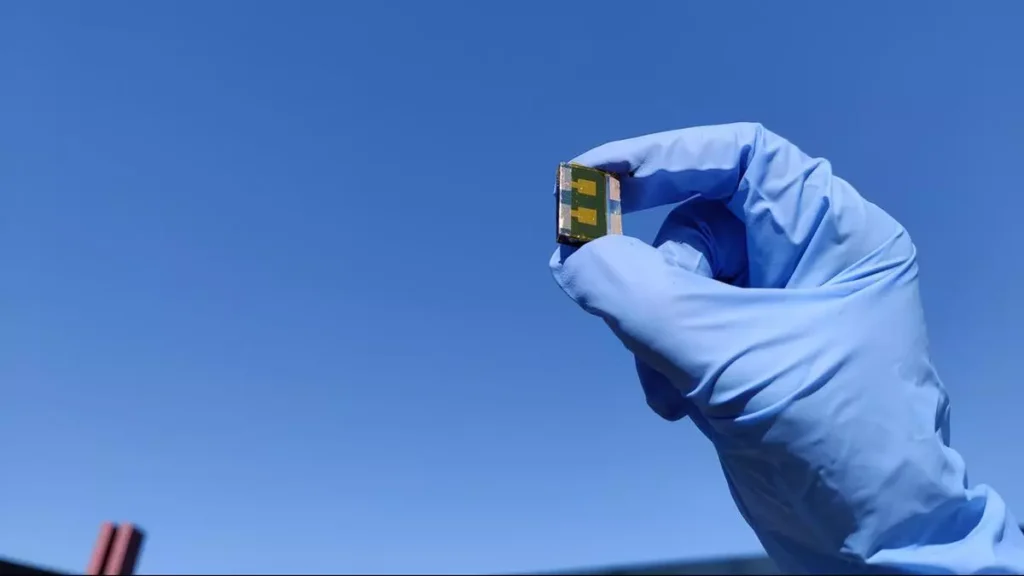A team of researchers from École Polytechnique Fédérale de Lausanne and Northwestern University has come up with a groundbreaking design for perovskite solar cells (PSCs). A perovskite is any material with a crystal structure following the formula ABXS , such as calcium titanium oxide (CaTiO ). The new design has a power conversion efficiency of 25.
3 per cent and shows remarkable resilience against degradation. The device maintains 95 per cent of its performance even after being subjected to rigorous conditions of 65°C and 50 per cent relative humidity for over 1,000 hours. The work was recently published in .
PSCs are at the forefront of solar energy innovation. Their manufacturing cost is low, and they have a high power conversion efficiency. However, achieving both high efficiency and long-term stability has been a significant obstacle to commercialising PSCs.
The solution hinges on controlling the interaction between the PSC layers. These layers increase the cells’ performance but also lead to rapid degradation. The team introduced an innovative concept called the “conformal self-assembled monolayer [SAM] on textured substrates” in which a distinct single layer of molecules naturally and uniformly covers the uneven surface of a textured substrate.
The new design addresses the problem of “molecular agglomeration”, when molecules cluster together and significantly impede performance. A special molecule called 3-mercaptopropionic acid was introduced into the solar cells’ SAM. This enhanced the contact between the perovskite material and the solar cell’s textured substrate, which ensures a more even distribution of the molecules in the SAM.
This enhances both the stability and efficiency of the PSC. The Loteta reservoir, near the town of Gallur, Spain, in March. | Photo Credit: Getty Images/iStockphoto The new global stocktake report from the UN Framework Convention on Climate Change (UNFCCC) finds that national climate action plans remain insufficient to limit global temperature rise to 1.
5°C and meet the goals of the Paris Agreement. While there is evidence that some countries have increased their efforts, the report shows much more action is needed now to bend the world’s emissions trajectory further downwards. “This means COP28 must be a clear turning point.
Governments must not only agree what stronger climate actions will be taken but also start showing exactly how to deliver them,” said Simon Stiell, the UNFCCC Executive Secretary, through a press release. COP28, the UN Climate Change Conference, will take place in Dubai from November 30 to December 12. The stocktake report is intended to inform the next round of climate action plans under the Paris Agreement (the nationally determined contributions, or NDCs) to be put forward by 2025.
The latest report of the Intergovernmental Panel on Climate Change indicates that greenhouse gas (GHG) emissions need to be cut by 43 per cent by 2030 compared with 2019 levels. This is critical to limit temperature rise to 1. 5°C by the end of this century.
“Every fraction of a degree matters, but we are severely off track…. Using the global stocktake to plan ahead, we can make COP28 a game changer,” Stiell said. The UNFCCC analysed the NDCs of 195 parties to the Paris Agreement.
According to the new report, while emissions are no longer increasing after 2030, compared with 2019 levels, they are still not demonstrating the rapid downward trend that science says is necessary this decade. If the latest available NDCs are implemented, current commitments will increase emissions by about 8. 8 per cent, compared with 2010 levels.
Last year’s assessment found that countries were on a path to increase emissions by 10. 6 per cent by 2030. By 2030, emissions are projected to be 2 per cent below 2019 levels, indicating that peaking of global emissions will occur within this decade.
To achieve peaking before 2030, the report says, “the conditional elements of the NDCs need to be implemented, which depends mostly on access to enhanced financial resources, technology transfer and technical cooperation, and capacity-building support; as well as the availability of market-based mechanisms”. A second UNFCCC report released alongside, on long-term low-emission development strategies, looked at countries’ plans to transition to net-zero emissions by or around mid-century. It notes that many net-zero targets remain uncertain and postpone into the future critical action that needs to take place now.
A sample of LionGlass, which requires significantly less energy to produce and is much more damage resistant than standard soda-lime-silicate glass. | Photo Credit: Adrienne Berard/Penn State. Creative Commons Glass manufacturing produces at least 86 million tonnes of carbon dioxide every year.
A research team at Pennsylvania State University has developed a new type of glass that promises to cut this carbon footprint by half. Called LionGlass (after Penn State’s Nittany Lion mascot), the invention requires significantly less energy to produce and is much more damage resistant than soda-lime-silicate glass, the common glass used in everyday items. “LionGlass eliminates the use of carbon-containing batch materials and significantly lowers the melting temperature of glass,” said John Mauro, the lead researcher who was quoted in the news release.
Soda-lime-silicate glass is made by melting three primary materials: quartz sand, soda ash (sodium carbonate), and limestone (calcium carbonate). Both soda ash and limestone release carbon dioxide (CO ) as they are melted. But the bulk of the CO emissions, according to Mauro, come from the energy required to heat furnaces to the high temperatures needed to melt glass.
With LionGlass, the melting temperatures are lowered by about 300°C to 400°C, which leads to a roughly 30 per cent reduction in energy consumption. LionGlass is also much stronger than conventional glass and possesses 10 times higher crack resistance compared with conventional glass, which cracks under a load of about 0. 1 kg force.
The limits of LionGlass is yet to be determined as the load that was reached was limited by the equipment. COMMents.
From: frontline_thehindu
URL: https://frontline.thehindu.com/science-and-technology/science-notebook-new-design-of-perovskite-solar-cell-unprecedented-efficiency-inadequacy-of-countries-climate-action-plans-making-glass-making-greener/article67557045.ece
